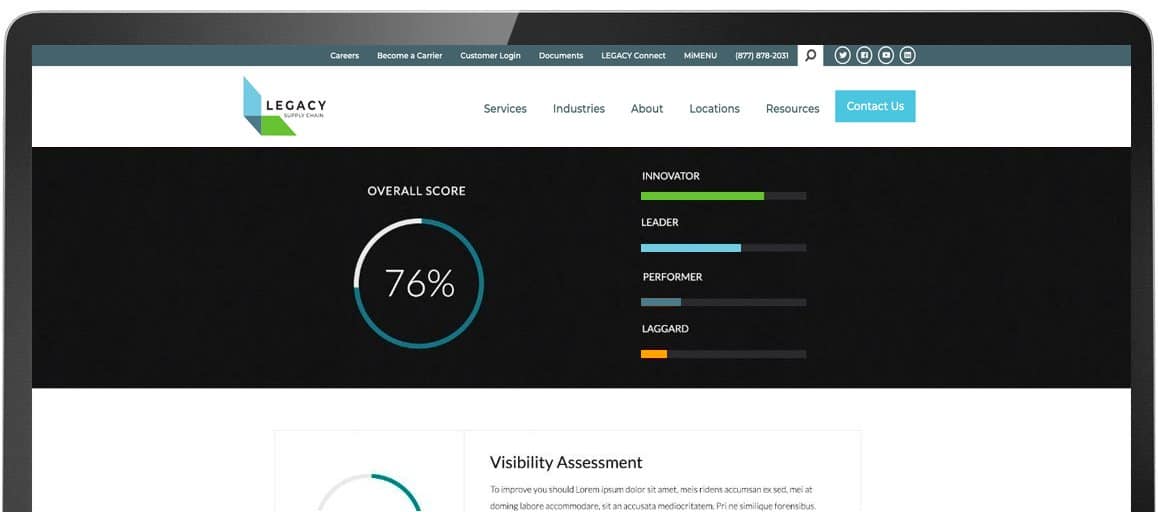A Simple Guide on How to Manage Warehouse Inventory

Omni-channel logistical success is predicated on a number of factors, one of the most important being warehouse inventory management. Inventory management in warehouses requires more than just organizing products (though that certainly helps): It requires the right alignment of network strategy, facility and process engineering, and technology systems that create inventory visibility and accuracy. The result is a heightened ability to deliver to your customer via their preferred sales channel, with a cost-to-serve that serves your bottom line.
Proper warehouse inventory management can be challenging but, if you follow this useful advice, you can increase efficiency and reduce costs.
What Is Warehouse Inventory Management?
Warehouse Management vs. Inventory Management
How to Manage Warehouse Inventory
Warehouse Inventory Management FAQs
What Is Warehouse Inventory Management?
Warehouse inventory management refers to the collective processes involved in receiving, storing and tracking warehouse inventory. It typically involves the following:
- Receiving: Raw materials or finished goods arrive at the warehouse, and workers unload deliveries, document inventory and place it on warehouse shelves.
- Inflow and Outflow Control: This is the regulation of the flow of goods into and out of the warehouse. The goal is to maintain stock levels at optimal levels to prevent both out-of-stock items and excess inventory.
- Order Fulfillment: This focuses on efficiently processing orders, picking the right items and ensuring timely and accurate delivery. It may also involve handling returns.
- Auditing and Inventory Management: Inventory management involves overseeing the entire lifecycle of each product and requires regular audits to verify the accuracy of inventory records and ensure alignment with the actual stock present.
- Location Tracking: This is the use of technology and manual checks to track the exact location of each item within the facility. This allows for efficient retrieval during order picking and improves overall operational accuracy.
- Replenishment Strategies: There should be predetermined minimum stock quantities to trigger replenishment actions, which includes restocking to maintain optimal levels based on historical sales data to ensure that the warehouse is well-equipped to meet future demand.
- Reporting and Analysis: Businesses need to review data generated throughout this process to identify bottlenecks and inefficiencies. It’s the best way to identify areas for improvement.
Effective warehouse management should be a holistic approach that accounts for all of these components to ensure seamless order fulfillment to meet customer demand.
What’s the Difference Between Warehouse Management and Inventory Management?
When we talk about inventory management, we’re specifically referring to goods stored in warehouses and storage facilities, rather than all products and materials held by a company. In this context, inventory management is a component within the larger warehouse management process.
- Warehouse management covers all the processes of the warehouse. It accounts for all functions of the warehouse, from receiving to tracking of inventory and to broader supply chain management. Warehouse management requires not just oversight over inventory, but management of personnel, equipment, software and more.
- Inventory management is the specific process that works to ensure optimal levels of inventory levels within the warehouse. It involves manually counting and spot-checking available inventory, dealing with backorders and handling support demand forecasting and inventory planning.
While there is overlap between the two processes, consider inventory management to be an important part of the larger warehouse management strategy.
How to Manage Warehouse Inventory
Reevaluate your warehouse design.
The layout of your warehouse should facilitate logical inventory flow, from receiving and inspection through to picking and packing, to ensure that operations move quickly and smoothly. A cramped, congested layout makes it difficult for inventory management personnel to access stock and leaves insufficient room for important processes such as receiving, which increases the risk of human error. It’s especially important to reevaluate your warehouse layout to accommodate increases in company sales, which contribute to increased space requirements.
When revising your warehouse design, ask yourself the following:
- Does my current layout utilize space efficiently?
- Do my employees have enough room to do their jobs properly?
- How long has it been since I last updated my layout? Have we experienced a significant increase in sales volume in that time?
- Do I want to incorporate any specific inventory logistics strategies into my layout (e.g. cross-docking, wave picking, etc.)?
Reorganize your stock keeping units (SKUs).
To ensure efficient operations and inventory management in your warehouse, organize products so that they’re easily accessible to inventory management personnel. This principle applies not only to your warehouse’s general layout but to your SKUs, as well. Strategically sort your SKUs and use slotting to group items together based on size, velocity, seasonality and other characteristics to reduce the amount of time employees spend searching for specific items.
You might also consider creating zones based on pick type to simplify order picking and reslotting. Place high volume, fast moving SKUs close to shipping areas in easy-to-reach locations so employees can retrieve them quickly. Finally, adopt lean inventory practices. By identifying and eliminating poor performing products, you can drastically reduce inventory levels and better enable employee efficiency during order fulfillment.
Invest in technology.
A warehouse management system (WMS) is a good place to start. A WMS is software designed to support and optimize warehouse functionality. A WMS can integrate systems and workflows, strategically organize execution systems, increase inventory visibility, mitigate the risk of demand volatility and more to ensure peak inventory management warehouse performance.
It’s also wise to invest in systems with business intelligence (BI) capabilities. BI uses technology to collect, analyze and transform data into actionable information. You can use this information to forecast inventory demand based on product and vendor performance, reduce excess inventory, put together fill rate reports, implement real-time inventory tracking and get an accurate account of what’s in-stock at any given point in time.
Automate everything.
One of the benefits of investing in technology is gaining the ability to automate essential workflows, including data collection, barcoding, scanning, picking and packing, shipping, inventory tracking and more. Automated inventory warehouse management allows for greater scalability, decreases the risk of human error, increases efficiency and saves time and money on manual labor. Once you’ve implemented inventory management warehouse technology, take care to regularly reevaluate your automation strategy to ensure that it continues to meet your business’s efficiency standards.
Enable your employees.
One of the best ways to improve overall inventory warehouse management is to make it easier for warehouse employees to do their jobs — and to do them efficiently. This can be as simple as setting strict safety standards to protect your employees from potential harm on the warehouse floor or adjusting your cleaning schedule to a more optimal time. Develop a detailed organization plan so that it’s easier for staff to identify where high-volume products are located.
From a technical perspective, use automation to maintain accurate records of all warehouse activities that employees can refer to on a moment’s notice. Whenever you implement new technology, take the time to host mandatory training sessions and familiarize all warehouse personnel with new software and systems. By empowering your staff with this valuable knowledge, you present them with additional opportunities to optimize inventory management on an everyday basis.
It goes without saying that an organized warehouse is an efficient warehouse. But even more than that, an organized warehouse plays an important role in driving omni-channel success across the supply chain. By implementing the practices listed above, as well as investing in the right software systems, you can simplify day-to-day operations, improve employee morale and move inventory faster.
Partnering with the right full-service, third-party logistics (3PL) provider is an effective means to manage and control your warehouse without having to divert resources from other areas of your business. As a trusted name with over 40 years of on-the-job experience, Legacy SCS can assist your operations through contract warehousing, or any other logistics services such as omni-channel distribution and eCommerce fulfillment.
Don’t hesitate to contact us with any questions you might have about warehouse management or if you’d like to learn more about any of our 3PL services or solutions.
Rapid, Sustainable Performance Improvements for Your Warehouse
Download our free whitepaper and start seeing sustainable results in just six to 12 months.
Download Your Copy
Warehouse Inventory Management FAQs
Why is warehousing management important?
Warehouse management isn’t just about your local inventory, it affects your entire supply chain. Poor warehouse inventory control will impact everything from receiving to order fulfillment and customer service. This can result in higher costs, greater chance of errors, unhappy employees and unsatisfied customers.
What’s the recommended way to avoid supply chain disruptions?
While you can’t prevent supply chain disruption, having a warehouse contingency plan can help you avoid the worst of it. Optimizing your inventory tracking and reporting can give you a clear picture of the flow of goods through your warehouse, giving you the chance to identify small problems before they become larger ones.
What’s the best way to keep track of inventory in the warehouse?
To optimize efficiency in inventory management, automate where you can using a warehouse management system (WMS). A WMS not only improves efficiency through automated processes, it is a powerful tool for generating analytics and insights. If you’re looking for the best way to integrate a solution, working with a 3PL provider is one of the best ways to quickly and seamlessly set up an inventory control system.
What are the benefits of a warehouse management system?
A good WMS will enable you to integrate different systems and workflows, increase inventory visibility, automate menial tasks and provide instant access to information. This can lead to improved warehouse safety and security, increased inventory accuracy, reduced labor costs and improved customer service levels. You also have the benefit of access to more data, enabling you to better analyze and optimize your operations.
Are there eCommerce fulfillment models that can integrate into a warehouse?
Yes. Pick and pack order fulfillment is a process where warehouse workers pick items from warehouse shelves and package them in individual boxes or envelopes for direct delivery to customers. This turns the warehouse into a distribution center, lowering costs and reducing shipping times. Read more about kitting and assembly, subscription box services and returns management to see different pick and pack options for your warehouse.
Get Insights. Stay Ahead.
Get the latest news and insights via email on warehouse improvement, transportation optimization, labor strikes and international shipping rate changes.Popular Posts
Search Posts
-
2024 Q1 Freight Landscape: Trends, Challenges, and Predictions
As the first quarter of 2024 comes to an end, here are some observations over the past few months as well as predictions about the trucking...
+ Read more -
Baltimore Bridge Impact Assessment – Update
Following the recent Baltimore Bridge collapse and subsequent port closures, we want to keep our customers informed about the situation and...
+ Read more -
Global Momentum Builds for Charge on Global Shipping Sector’s CO2 Emissions
A growing coalition of 47 countries, including key players like the European Union, Canada, Japan, and various Pacific Island nations, is...
+ Read more










